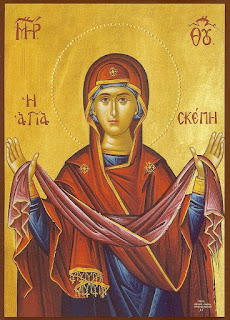01 October 2017
Pokrov, to the Slav (and to the Chinese)
Today, on the New Calendar, was the celebration of the Feast of the Protection of Our Most Holy Lady Theotokos and Ever-Virgin Mary, which is remembered with the greatest observance by the Slavic peoples of Eastern Europe. (My little two-year-old’s partly-Yugoslav descent was ably proven today. He knocked over the vase of flowers in front of the ikon of Father Saint Herman of Alaska, spilling water everywhere to the great embarrassment of his father. I was later assured that this is something of a rite-of-passage for kids at Saint Herman’s OCA – they’re not really members until they’ve knocked something over.) It also happens to be China’s National Day (Guoqingjie 国庆节), which means that my in-laws in the Central States were busy celebrating also.
It’s possible to draw some specious parallels between the two observances, of course. The veil (Pokrov means both ‘veil’ and ‘protection’) of the Holy Theotokos is dyed deep red, and marked with golden stars; and this bears something a resemblance to the flag of China which was adopted on this day sixty-eight years ago. The veil of the Theotokos is red to demonstrate the divine presence that overshadowed her, and marked with three golden stars to signify her perpetual virginity. However, the flag of Mao’s China is red to signify revolution, and the stars represent the Party and the four social classes, arranged in the pattern of a begonia flower. Yes, there are five stars, not three. And yes, the stars each have five points, not eight. The likeness of the communist flag to the veil of the Theotokos is still there. I wouldn’t go so far as to say the likeness is purely accidental. It’s not; Marxism is a Christian heresy and resemblances between Marxism and Christianity are seldom accidental. But it is trivial.
The more important parallel to be drawn is that in each case, the commemoration is that of an end of a war. The Chinese Civil War ended in September of 1949, and the People’s Republic was proclaimed on the first of October of that year. Eleven centuries before that, a massive fleet of Rus’ ships was preparing to attack Constantinople. A former slave and holy fool, Saint Andrew, who belonged to one tribe of the Slavs, had a vision of the Theotokos kneeling before the altar at the church at Blachernæ and praying to her Son for the protection of all the Christians of the world. When her prayer was ended, she took her veil and spread it over the common people gathered in the church, a promise of her protection. Saint Andrew turned to his disciple Saint Epiphanios and asked him: ‘Do you see, brother, the Holy Theotokos, praying for all the world?’, to which the disciple replied: ‘I do see, Holy Father, and am in awe!’
The heathen Rus’ fleet which threatened Constantinople, so says the Primary Chronicle, was destroyed in a storm; this destruction was attributed to the intercession of the Theotokos after the veil of the Theotokos was dipped into the sea waters at Blachernæ. Constantinople was spared. Interestingly, the Rus’ began to celebrate this feast with greater attention than the Greeks themselves do – the OCA’s description of the feast notes this fact as ‘ironic’, which it is. (Far be it from me to gainsay a good ironic twist!) But I’m not so certain that the irony is the whole story.
It is a healthy and normal impulse (though still a pagan one) to do as the mainland Chinese do today: to celebrate a victory in war. But Orthodoxy overturns that normal logic, and radicalises it – and no group of people has managed to submit so fully to that logic as the Rus’. It is in keeping with the unique character of the Christianised Slavs to celebrate even a defeat when that defeat was justified. I will get into this more in a later post, but even the Kievan chroniclers acknowledged that the terrible retribution visited upon them by Knyaz Saint Andrei was justified on account of the grievous sins of their Metropolitan, and it is not unknown for Russian localities to venerate even ‘enemy’ saints. It is not out-of-character for the descendants of the Rus’, that they began to celebrate the destruction of their forefathers’ fleet through the prayers of the people of Constantinople and the intercession of the Holy Theotokos. In this sense, the original Christian impulse has been far more radical, on the psychological level, than the Marxism that took hold in place of that impulse.
Interestingly enough, there is another connexion. One of the few active, surviving Orthodox churches in China is located in Harbin, and is dedicated to the Pokrov of the Holy Theotokos. I am not surprised that a mission which began among a people – the Albazinian Cossacks – defeated in a border skirmish with the Manchus, a people who survived wholly through the protection of the Theotokos themselves, would so dedicate their mission and submit themselves to her prayers.
In any event: enough of my tenuous ramblings. A joyous feast of the Protection of the Holy Theotokos, and a happy National Day for those who observe each!
Labels:
Elláda,
history,
Holmgård and Beyond,
Huaxia,
lefty stuff,
mediæval nonsense,
personal,
Pravoslávie,
theology
Subscribe to:
Post Comments (Atom)














No comments:
Post a Comment